Three Dimensional Bioprinted Tumor Models for Drug Testing
a three-dimensional bioprinting and tumor technology, applied in the field of three-dimensional bioprinting tumor models for drug testing, can solve the problems of loss of heterogeneity that is required to accurately mimic human disease, short life span, inbreeding, etc., and achieve the effect of accurate screening
- Summary
- Abstract
- Description
- Claims
- Application Information
AI Technical Summary
Benefits of technology
Problems solved by technology
Method used
Image
Examples
example 1
ng of Stromal Tissue Block
[0365]The stromal compartment comprised human mammary fibroblasts, endothelial cells, and preadipocytes printed as a solid cube measuring approximately 2 mm×2 mm×2 mm. In order to track the position of the bioprinted cells or implanted cells, a red fluorescent dye (CellTracker CMRA Orange (ThermoFisher)) was incorporated into the bioprinted tissue.
example 2
ioning of Stromal Tissue Block
[0366]Bioprinted stromal tissues were cross-linked with 50 mM calcium chloride and cultured in a rolling bioreactor in 50 mL vented cap tubes (CellTreat) at 18 rpm for 3 days. Tissues were treated with 50 mg / mL alginate lyase overnight in the bioreactor tube, and cultured in the bioreactor for 4 additional days in culture media to prepare the stromal tissues. Preconditioned tissues cultured in the rolling bioreactor exhibited a dense capsule of fibroblasts on the outer surface of the tissue that permitted incision with a scalpel. See FIG. 2.
example 3
ion of Primary Human Solid Tumor Fragment into Stromal Tissue Block
[0367]Small segments of human breast cancer tissue (approximately 0.5 mm×0.5 mm×0.5 mm) were then implanted into the interior of the bioprinted stromal tissue following the creation of a small incision. The wound induced during implantation is self-sealing and does not require a suture or adhesive to retain the tumor tissue in the interior of the structure.
PUM
 Login to View More
Login to View More Abstract
Description
Claims
Application Information
 Login to View More
Login to View More - R&D
- Intellectual Property
- Life Sciences
- Materials
- Tech Scout
- Unparalleled Data Quality
- Higher Quality Content
- 60% Fewer Hallucinations
Browse by: Latest US Patents, China's latest patents, Technical Efficacy Thesaurus, Application Domain, Technology Topic, Popular Technical Reports.
© 2025 PatSnap. All rights reserved.Legal|Privacy policy|Modern Slavery Act Transparency Statement|Sitemap|About US| Contact US: help@patsnap.com



